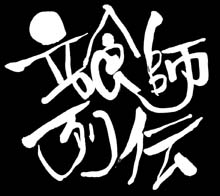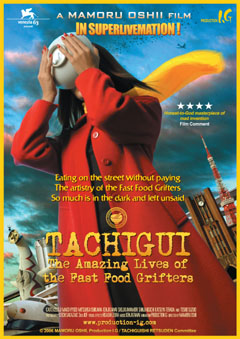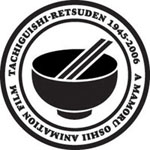OVERVIEW

The Amazing Lives
of the Fast Food Grifters
Introduction
I don't feel any nostalgia looking back
to my formative years during the 50s and 60s.
At the time, I wanted my world to become
like the one portrayed in American movies
as soon as possible.
But as it was becoming a reality,
it was not what I had imagined.
We had become prosperous,
but I didn't feel any sense of hope.
(Mamoru Oshii)
Mamoru Oshii's latest animated feature film shakes one entire nation's dietary history!
After Innocence, the first Japanese animated film nominated for the Palme d'Or at the Festival de Cannes, Mamoru Oshii has turned his focus to his life-time passion, an endless quest for the ultimate fast food that no one has ever explored before. And the result of this quest has now become a full-length feature film: Tachigui: The Amazing Lives of the Fast Food Grifters.
"I still remember well what I was eating each time something happened," says Oshii. "So by talking about what we've been eating, I think we can illuminate the age we've lived."
Always known as the relentless visual pioneer who has been pushing the boundaries of animation and live action, Oshii declares with confidence, "The movie is something that no one has seen before." It could be described as a 3D-CG recreation of a documentary drama of a fictional post-war history staged in a small theatre and performed as a simple paper puppet show. Oshii realized that traditional animation could not be convincing enough to describe historical past, and at the same time, the reconstruction of 50 years of Japanese history could not be possible by a live action movie. Therefore he decided for a third way, in which a mockumentary unfolds with an intentionally phoney visual technique. 90% in the movie is false, parody or illusive. Even sequences apparently coming from archive footage are in fact full 3D CG animation. "But in the remaining 10% lays the true message of the film. In my intention, this is a very seriously made comedy movie," Oshii explains.
The film is based on the original novel written by Oshii himself.

About Fast Food Grifters
Some people glorify Fast Food Grifters
as maverick heroes who have carved their names
in the history of dietary culture.
Some accuse them of destroying the public order.
And others simply dismiss them as pure fiction.
(from "Tachigui: The Amazing Lives of the Fast Food Grifters")
"Tachigui" literally means "stand-and-eat." It is a word that may find rough English equivalent in the expression "fast food." In vastly urbanized Japan, everybody has experienced tachigui or fast food in his/her life, in a broader meaning that includes not only global hamburger giants, but also cheap and popular soba stalls or gyudon (beef and rice bowl) restaurant chains. Oshii is convinced that history and evolution of tachigui through the decades in Japan is somehow deeply interlinked with the nation's mainstream history, starting from the aftermath of World War II, until the end of the Showa Era (1989), just before the burst of the bubble economy.
The heroes of this still unsaid history of Japan are called Fast Food Grifters. By exposing extreme erudition or haranguing the restaurant owner with refined rhetoric skills, the Fast Food Grifters will get way without paying for their noodles. They stake their life on nothing, it is their ambition that is fulfilled. But each Fast Food Grifter, with his strong personality and unique modus operandi, incarnates the age he has lived in, thus sharply reflecting Mamoru Oshii's satirical view of modern society. The director declares that his latest effort is in fact his lifework, and the Fast Food Grifters have often appeared throughout his oeuvre, such as in Urusei Yatsura or the live action The Red Spectacles.

About Superlivemation
I started out as an animation director
and later took up live-action movies as well.
This technique is innovative
since it more or less eliminates
any discontents I had for either of the methods.
(Mamoru Oshii)
Tachigui: The Amazing Lives of the Fast Food Grifters adopts a revolutionary animation technique, called "superlivemation": real people and locations were first photographed, and then digitally processed and animated with a paper puppet theater-style (cardboard cutout designs on sticks). Oshii himself describes this method as either "a live-action movie with extremely limited information" or "a simple animation with extremely intense information." Photographer Keiichi Sakazaki and Oshii himself took more than 30,000 snapshots, and the process from the raw picture to the final compositing required 20 steps. The extraordinary cast includes Toshio Suzuki (Studio Ghibli's producer), Kenji Kamiyama (Ghost in the Shell: Stand Alone Complex director), Shoji Kawamori (Macross and Aquarion director), Kenji Kawai (Innocence music composer), Shinji Higuchi (Lorelei director, Gamera 3 SFX director) and Katsuya Terada (Blood: The Last Vampire designer) among the others.
Release in Japan: April 8, 2006
Format: 1 x 104
© 2006 MAMORU OSHII, Production I.G / TACHIGUISHI RETSUDEN Committee
STORY

The Amazing Lives
of the Fast Food Grifters
Eating on the street without paying
The artistry of the Fast Food Grifters
So much is in the dark and left unsaid
| 1945. Immediately following the end of the World War II, Tokyo was trying to emerge from the rubble. In a corner of the black market stood a flimsy soba (buckwheat noodle) eatery. It was a delicate time just before the closing. A man appeared at the threshold. "One moongaze (raw egg). With soba." This was none other than the legendary Fast Food Grifter known as Moongaze Ginji. His relentless scam quietly initiates. The time changes. In the midst of the first anti Japan-US Security Treaty movement (1960), the streets rumored about Foxy Croquette O-Gin, a beautiful lady Fast Food Grifter, who disappeared all of a sudden. Wandering the alleys in the years of the economic miracle was Crying Inumaru, the loser. Then came Cold Badger Masa, whose scandalous death made people aware of the presence of Fast Food Grifters within the Japanese society. Beefbowl Ushigoro put an end to a major gyudon (beef and rice bowl) restaurant chain. And it is not possible not to mention Hamburger Tetsu, who shocked the entire fast food industry. Fast Food Grifters are the phantoms that rise and fall with the shifting diet-styles. They are the dissenting heroes who carved their names on the dark side of dietary culture with their glare. Now their legend revives, strong as ever... Release in Japan: April 8, 2006
|    |

© 2006 MAMORU OSHII, Production I.G / TACHIGUISHI RETSUDEN Committee

![WORK LIST[DETAILS]](/contents/works/design/images/left_title.gif)



 terms of use
terms of use